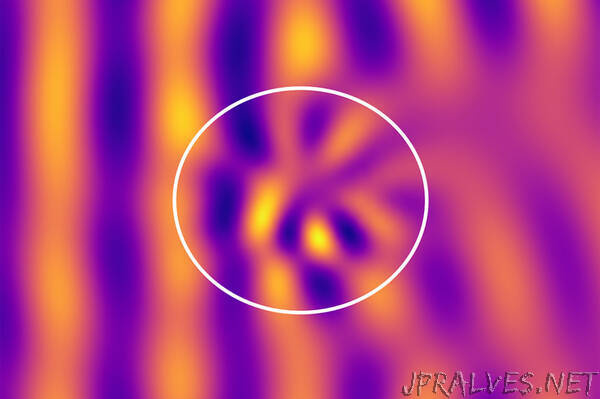
“By incorporating the scattering of RF waves into fusion simulations, MIT physicists improve heating and current drive predictions for fusion plasmas.
In the quest for fusion energy, understanding how radio-frequency (RF) waves travel (or “propagate”) in the turbulent interior of a fusion furnace is crucial to maintaining an efficient, continuously operating power plant. Transmitted by an antenna in the doughnut-shaped vacuum chamber common to magnetic confinement fusion devices called tokamaks, RF waves heat the plasma fuel and drive its current around the toroidal interior. The efficiency of this process can be affected by how the wave’s trajectory is altered (or “scattered”) by conditions within the chamber.
Researchers have tried to study these RF processes using computer simulations to match the experimental conditions. A good match would validate the computer model, and raise confidence in using it to explore new physics and design future RF antennas that perform efficiently. While the simulations can accurately calculate how much total current is driven by RF waves, they do a poor job at predicting where exactly in the plasma this current is produced.
Now, in a paper published in the Journal of Plasma Physics, MIT researchers suggest that the models for RF wave propagation used for these simulations have not properly taken into account the way these waves are scattered as they encounter dense, turbulent filaments present in the edge of the plasma known as the “scrape-off layer” (SOL).
Bodhi Biswas, a nuclear science and engineering PhD candidate working at the Plasma Science and Fusion Center (PSFC) under the direction of Senior Research Scientist Paul Bonoli, School of Engineering Distinguished Professor of Engineering Anne White, and Principal Research Scientist Abhay Ram, is the paper’s lead author. Ram compares the scattering that occurs in this situation to a wave of water hitting a lily pad: “The wave crashing with the lily pad will excite a secondary, scattered wave that makes circular ripples traveling outward from the plant. The incoming wave has transferred energy to the scattered wave. Some of this energy is reflected backwards (in relation to the incoming wave), some travels forwards, and some is deflected to the side. The specifics all depend on the particular attributes of the wave, the water, and the lily pad. In our case, the lily pad is the plasma filament.”
Until now, researchers have not properly taken these filaments and the scattering they provoke into consideration when modeling the turbulence inside a tokamak, leading to an underestimation of wave scattering. Using data from PSFC tokamak Alcator C-Mod, Biswas shows that using the new method of modeling RF-wave scattering from SOL turbulence provides results considerably different from older models, and a much better match to experiments. Notably, the “lower-hybrid” wave spectrum, crucial to driving plasma current in a steady-state tokamak, appears to scatter asymmetrically, an important effect not accounted for in previous models.
Biswas’s advisor Paul Bonoli is well acquainted with traditional “ray-tracing” models, which evaluate a wave trajectory by dividing it into a series of rays. He has used this model, with its limitations, for decades in his own research to understand plasma behavior. Bonoli says he is pleased that “the research results in Bodhi’s doctoral thesis have refocused attention on the profound effect that edge turbulence can have on the propagation and absorption of radio-frequency power.”
Although ray-tracing treatments of scattering do not fully capture all the wave physics, a “full-wave” model that does would be prohibitively expensive. To solve the problem economically, Biswas splits his analysis into two parts: (1) using ray tracing to model the trajectory of the wave in the tokamak assuming no turbulence, while (2) modifying this ray-trajectory with the new scattering model that accounts for the turbulent plasma filaments.
“This scattering model is a full-wave model, but computed over a small region and in a simplified geometry so that it is very quick to do,” says Biswas. “The result is a ray-tracing model that, for the first time, accounts for full-wave scattering physics.”
Biswas notes that this model bridges the gap between simple scattering models that fail to match experiment and full-wave models that are prohibitively expensive, providing reasonable accuracy at low cost.
“Our results suggest scattering is an important effect, and that it must be taken into account when designing future RF antennas. The low cost of our scattering model makes this very doable.”
“This is exciting progress,” says Syun’ichi Shiraiwa, staff research physicist at the Princeton Plasma Physics Laboratory. “I believe that Bodhi’s work provides a clear path to the end of a long tunnel we have been in. His work not only demonstrates that the wave scattering, once accurately accounted for, can explain the experimental results, but also answers a puzzling question: why previous scattering models were incomplete, and their results unsatisfying.”
Work is now underway to apply this model to more plasmas from Alcator C-Mod and other tokamaks. Biswas believes that this new model will be particularly applicable to high-density tokamak plasmas, for which the standard ray-tracing model has been noticeably inaccurate. He is also excited that the model could be validated by DIII-D National Fusion Facility, a fusion experiment on which the PSFC collaborates.
“The DIII-D tokamak will soon be capable of launching lower hybrid waves and measuring its electric field in the scrape-off layer. These measurements could provide direct evidence of the asymmetric scattering effect predicted by our model.””
